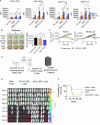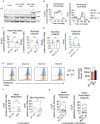Directing B7-H3 chimeric antigen receptor T cell homing through IL-8 induces potent antitumor activity against pediatric sarcoma
- PMID: 39043604
- PMCID: PMC11268054
- DOI: 10.1136/jitc-2024-009221
Directing B7-H3 chimeric antigen receptor T cell homing through IL-8 induces potent antitumor activity against pediatric sarcoma
Abstract
Background: Advances in pediatric oncology have occurred for some cancers; however, new therapies for sarcoma have been inadequate. Cellular immunotherapy using chimeric antigen receptor (CAR) T cells has shown dramatic benefits in leukemia, lymphoma, and multiple myeloma but has been far less successful in pediatric solid tumors such as rhabdomyosarcoma (RMS) and osteosarcoma (OS). Balancing issues of "on-target, off-tumor toxicity", investigators have identified B7-H3 as a broadly expressed tumor antigen with otherwise restricted expression on normal tissues. We hypothesized that rapid homing via a chemokine receptor and CAR engagement through B7-H3 would enhance CAR T cell efficacy in solid tumors.
Methods: We generated B7-H3 CAR T cells that also express the Interleukin-8 (IL-8) receptor, CXCR2. Cytokine production, flow cytometry, Seahorse assays and RNA sequencing were used to compare the B7-H3 CXCR2 (BC2) CAR T cells with B7-H3 CAR T cells. We developed an IL-8 overexpressing human RMS mouse model to test homing and cytotoxicity in vivo.
Results: We demonstrate that IL-8 is expressed by RMS and OS and expression significantly increases after radiation. Overexpression of an IL-8 receptor, CXCR2, on B7-H3 CAR T cells enhances homing into IL-8 expressing tumors, augments T cell metabolism and leads to significant tumor regression.
Conclusion: These findings warrant further investigation into the use of BC2 CAR T cells as a treatment for patients with RMS, OS and other B7-H3-expressing, IL-8 producing solid tumors.
Keywords: Adoptive cell therapy - ACT; Chimeric antigen receptor - CAR; Immunotherapy; Solid tumor.
© Author(s) (or their employer(s)) 2024. Re-use permitted under CC BY-NC. No commercial re-use. See rights and permissions. Published by BMJ.
Conflict of interest statement
Competing interests: US Patent (University of Colorado): W02022221592: Compositions and methods for producing and using cell-based immunotherapies to target tumors (inventors: MRV and JAL).
Figures






Similar articles
-
Redirecting B7-H3.CAR T Cells to Chemokines Expressed in Osteosarcoma Enhances Homing and Antitumor Activity in Preclinical Models.Clin Cancer Res. 2024 Oct 1;30(19):4434-4449. doi: 10.1158/1078-0432.CCR-23-3298. Clin Cancer Res. 2024. PMID: 39101835 Free PMC article.
-
CAR T Cells Targeting B7-H3, a Pan-Cancer Antigen, Demonstrate Potent Preclinical Activity Against Pediatric Solid Tumors and Brain Tumors.Clin Cancer Res. 2019 Apr 15;25(8):2560-2574. doi: 10.1158/1078-0432.CCR-18-0432. Epub 2019 Jan 17. Clin Cancer Res. 2019. PMID: 30655315 Free PMC article.
-
B7-H3-Targeting Chimeric Antigen Receptors Epstein-Barr Virus-specific T Cells Provides a Tumor Agnostic Off-The-Shelf Therapy Against B7-H3-positive Solid Tumors.Cancer Res Commun. 2024 Jun 4;4(6):1410-1429. doi: 10.1158/2767-9764.CRC-23-0538. Cancer Res Commun. 2024. PMID: 38717140 Free PMC article.
-
B7-H3-targeted CAR-T cell therapy for solid tumors.Int Rev Immunol. 2022;41(6):625-637. doi: 10.1080/08830185.2022.2102619. Epub 2022 Jul 20. Int Rev Immunol. 2022. PMID: 35855615 Review.
-
Chimeric antigen receptor T (CAR-T) cell immunotherapy for sarcomas: From mechanisms to potential clinical applications.Cancer Treat Rev. 2020 Jan;82:101934. doi: 10.1016/j.ctrv.2019.101934. Epub 2019 Nov 25. Cancer Treat Rev. 2020. PMID: 31794912 Review.
Cited by
-
B7-H3 in Cancer Immunotherapy-Prospects and Challenges: A Review of the Literature.Cells. 2025 Aug 6;14(15):1209. doi: 10.3390/cells14151209. Cells. 2025. PMID: 40801642 Free PMC article. Review.
-
Tumor-derived G-CSF induces an immunosuppressive microenvironment in an osteosarcoma model, reducing response to CAR.GD2 T-cells.J Hematol Oncol. 2024 Dec 18;17(1):127. doi: 10.1186/s13045-024-01641-7. J Hematol Oncol. 2024. PMID: 39695851 Free PMC article.
References
MeSH terms
Substances
Grants and funding
LinkOut - more resources
Full Text Sources
Research Materials
